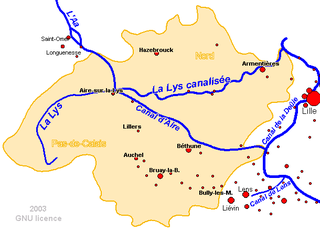Canal d'Aire
| Canal d'Aire | |
|---|---|
|
Sketch of the canal course |
|
| Water code | FR : E35-0282 |
| location | France , Hauts-de-France region |
| length | 39 km |
| Built | Commissioned in 1825 |
| Expanded | Late 1960s |
| class | Va |
| Beginning | Branch from the canalised Deûle at Bauvin |
| The End | Crossing into the Canal de Neuffossé at Aire-sur-la-Lys |
| Descent structures | Cuinchy |
| Ports | Aire-sur-la-Lys, Isbergues, Béthune, Beuvry, La Bassée |
| Junctions, crossings | channeled Lys |
| Downhill | Direction Aire-sur-la-Lys |
| Responsible WSD | Nord-Pas-de-Calais / Subdivision Saint-Omer |
| Part of the large shipping route Dunkirk-Scheldt | |
| Plaque in the old town port of Aire-sur-la-Lys | |
The Canal d'Aire (also: Canal d'Aire à La Bassée , German 'La Bassée Canal') is a French shipping canal that runs in the Nord and Pas-de-Calais departments in the Hauts-de-France region .
geography
The canal connects the rivers Deûle and Leie (French: Lys ) and continues in the Canal de Neuffossé towards Dunkirk . Today it is part of the large shipping route Dunkirk-Scheldt .
Course and technical infrastructure
It is a connecting channel with a minimum height difference of about two meters. It begins opposite Bauvin , where it connects to the canalised Deûle in the form of a canal triangle . The canal runs generally west to northwest, passes the town of Béthune and reaches the canalized Leie at Aire-sur-la-Lys , which branches off to the east. He himself goes over here into the Canal de Neuffossé , which is the continuation of the large shipping route towards Dunkirk. The Canal d'Aire is around 39 km long and has only one lock in Cuinchy , which is dimensioned for pushed convoys with a loading capacity of up to 3000 tons.
Coordinates
- Starting point of the canal: 50 ° 31 ′ 28 " N , 2 ° 53 ′ 2" E
- End point of the canal: 50 ° 38 ′ 42 " N , 2 ° 24 ′ 38" E
Places on the canal
history
The first plans and concepts for this canal date back to 1271. A serious start was made in 1660 and commissioning took place in 1825. The locks, originally built in the Freycinet format, were rebuilt in the 1970s and 1980s, the canal straightened, widened and deepened and integrated into the large shipping route Dunkirk-Schelde. From the old route you can still see abandoned city crossings z. B. in La Bassée, Béthune and Aire-sur-la-Lys.
During the First World War, the canal was an obstacle for the attacking German troops.
In June 1940 Theodor Eicke tried, contrary to orders and in vain, to cross the La Bassée Canal during the Battle of Dunkirk near Béthune . His SS division "Totenkopf" suffered considerable losses.
Web links
- Canal d'Aire à La Bassée near SANDRE (French)
- Entry in the Babel project (French)
swell
- Map from geoportail.fr (1: 16,000) , accessed October 10, 2011
- David Edwards-May: Inland waters of France, all navigable rivers and canals . Edition Maritim, Hamburg 1997, ISBN 3-922117-61-9 .

